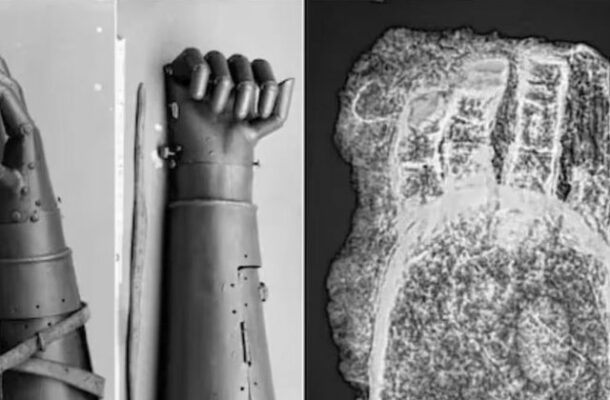Discover the fascinating tale of a 600-year-old artificial hand found in Germany. Unravel the mystery behind this medieval prosthetic as German archaeologists shed light on a centuries-old technological marvel.
Introduction: In a groundbreaking archaeological discovery, German researchers have unearthed a remarkable relic from the past—a 600-year-old artificial hand. Carbon dating places this intricate iron prosthetic in the time span between 1450 and 1620, offering a rare glimpse into the life of its long-forgotten owner. The enigma surrounding this medieval technological marvel deepens as scientists attempt to decipher how the wearer lost his fingers and adapted to this early form of prosthesis.
The Iron Hand's Silent Testimony
Walter Irlinger, the head of the Conservation Department at the Bavarian State Office for the Preservation of Monuments, sheds light on the find. The prosthesis, crafted from sheet metal, replaces the index, middle, ring, and little fingers on the left hand. Immobile yet ingeniously designed, these prosthetic fingers, slightly curved and parallel, hint at the craftsmanship of a bygone era. Irlinger speculates that the prosthesis was likely affixed to the trunk of the hand, emphasizing the artistry and functionality of this ancient creation.
Gauze-Like Comfort: A Surprising Detail
Further examination of the prosthetic hand reveals a gauze-like material within, suggesting that the wearer might have used it to cushion the interaction between the artificial limb and the hand's trunk. This delicate touch adds a human dimension to the technological advancement of the time, highlighting the wearer's adaptability and the intricate thought put into the design.
Freising's Silent Witness
The skeleton bearing this extraordinary prosthesis was discovered in a grave near a church in Freising, near Munich, Germany. Freising, a witness to numerous military conflicts, including the devastating Thirty Years' War, offers a historical backdrop to the find. The surge in amputations during this period, driven by warfare, likely fueled the demand for such prosthetics.
A Commonplace Marvel of the Past
Surprisingly, this type of prosthesis was not a rarity during that era. Archaeologists have previously uncovered about 50 similar prostheses in Central Europe, spanning from the late Middle Ages (1300-1500) to the early modern period (1500-1800). Notably, the 16th-century German knight Götz von Berlichingen's advanced prosthetic hand, designed with mobility and technical complexity, stands out as a testament to the sophistication of medieval prosthetics.
Tracing Roots: Ancient Prosthetics
Delving deeper into history, the discovery in Germany echoes ancient prosthetic marvels. The National Library of Medicine notes the existence of a single finger prosthesis from Egypt dating back 2,600 to 3,400 years ago. Meanwhile, the "Capua leg," a prosthetic leg from Italy crafted around 300 BC for a Roman nobleman, showcases the enduring pursuit of mobility and normalcy.
In unraveling the story behind this 600-year-old artificial hand, archaeologists not only delve into the technological prowess of the past but also human resilience in the face of adversity. As the iron fingers of history point towards a forgotten narrative, the world is reminded of the silent triumphs that echo through the ages.


Comments